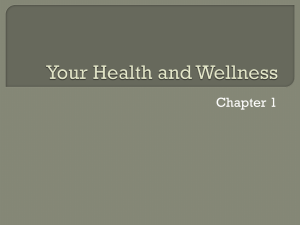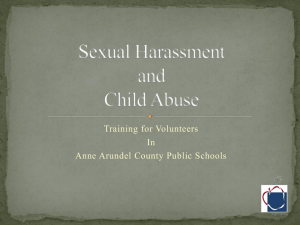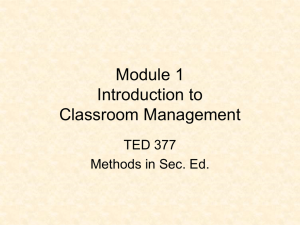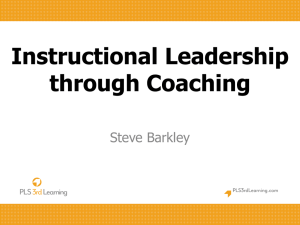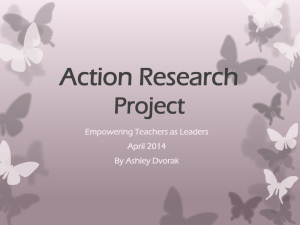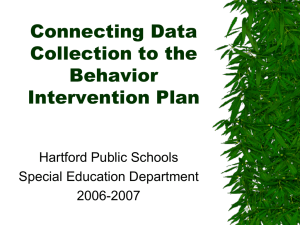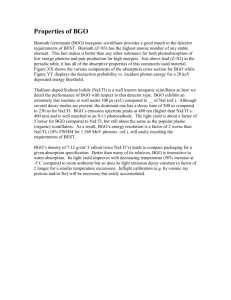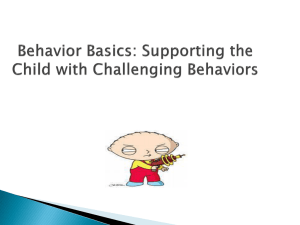Managing Difficult Students: Verbal De
advertisement
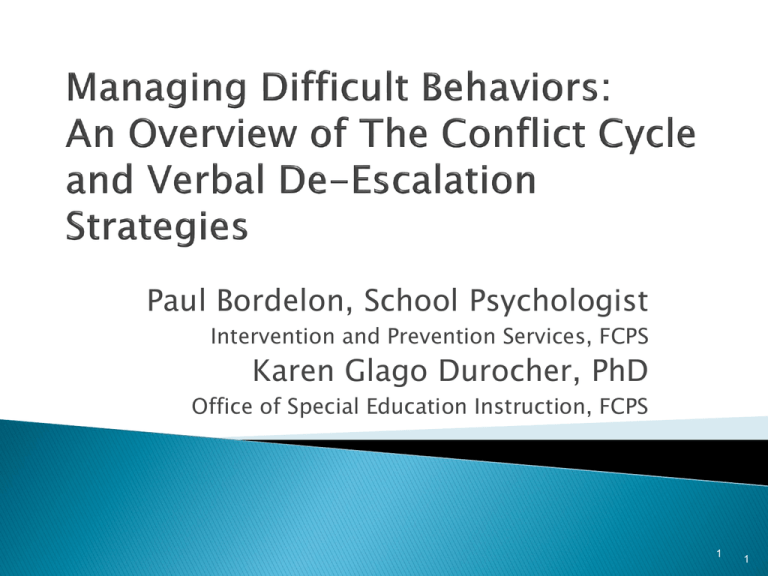
Paul Bordelon, School Psychologist Intervention and Prevention Services, FCPS Karen Glago Durocher, PhD Office of Special Education Instruction, FCPS 1 1 • Provide an overview of the nature of acting out behavior • Review of teacher and staff roles in the conflict cycle • Review Strategies to address common problem behaviors in the classroom 2 2 Managing difficult behavior is like a _______ because ________ 3 Managing behavior is all about what we say and do! (Colvin, 2004) 4 4 Manage minor problem behaviors quickly and efficiently Plan, teach, and implement predetermined hierarchy of consequences Implement in order consistently For example for the first rule infraction-Reteach Signal occurrence Tell the student the correct response Ask student to restate/demonstrate Disengage AVOID POWER STRUGGLES 5 Level 1: Class Verbal Reminder Level 2: Nonverbal Cues Level 3: Student Specific Reminder/Modification Level 4: Private Conference Level 5: Time Away ( in- or out-of-class) Level 6: Parent Conference Level 7: TIME OUT ROOM 6 Steps 1-4: Emphasis on prevention and teaching Steps 5-7: Emphasis on safety, crisis management, re-entry and follow-up procedures http://iris.peabody.vanderbilt.edu/bi1/bi1_02.html 7 8 Overall student behavior is cooperative and acceptable. ◦ Respond to teacher directions and praise ◦ Accept corrective feedback ◦ Engages in and completes work ◦ Ignore distractions and/or inappropriate behaviors of others http://www.iris.peabody.vanderbilt.edu/bi1/bi 1_03.html 9 Analyze design of physical space of the classroom Create a practical schedule Establish high classroom expectations for all Use predictable classroom routines Manage instruction, incorporate best practices Teach behaviors while students are in calm phase PLAN IT OUT! 10 11 • Triggers also referred to as setting events, aversive stimuli, antecedents, etc. • Overall behavior is a series of unresolved conflicts – School-based examples • Repeated failures, frequent corrections, teasing, conflicts with other students, etc… – Nonschool-based examples • Argument with parent, no breakfast, substance abuse, family member illness, Inadequate, sleep, etc… 12 Identify the context (trigger) and predictable behavior problem Specify expected behaviors Modify the context Conduct behavior rehearsals Provide strong reinforcement for occurrences of expected behaviors Prompt expected behaviors 13 14 • Observe student’s body language – Limited eye contact/veiled eyes – Busy hands – tapping pencils, rubbing legs, wringing hands – Moving in and out of groups with no goal directed purpose – Off task/head down – Starring into space • Listen to student’s response – Unwillingness to talk/disrespectful tone – Close ended short responses 15 15 • Occurs due to an inability to handle trigger • Noticeable change in behavior – Rise in level of stress – Loss of attention and concentration – Increase in off-task behavior • May last a long time • Signals the possibility that an acting-out behavior may develop – Prime opportunity to intervene and change the course of the behavior (and quite possibly your day!) 16 16 Offer teacher empathy Assist student with task Provide space Offer assurances and additional time Permit preferred activities (within set parameters) Change activities (independent, passive, movement) Maintain teacher proximity Use student self-management where appropriate 17 18 • Behavior becomes focused and directed typically at staff – – – – – – – – Questioning and arguing Noncompliance and defiance Disruptive behaviors Provoking of others Limit testing Whining and crying Inappropriate verbalizations (e.g., threats) Destruction of property… 19 19 • Consciously avoid escalating prompts that lead to more serious behaviors: – Shouting – Engaging in power struggles – Moving into the student’s space – Touching the student – Sudden or very quick movements – Using “put-down” statements – Becoming defensive and arguing – Communicating anger and frustration through body language 20 20 • Remain calm, detached, and respectful – PAUSE – The most powerful response is no immediate response. • Realize the student is playing a game • Don’t take it personally! • Use your predetermined procedures • Utilize non-confrontational limit-setting procedures – Establish initial set-up – Present the information as a decision – Follow-through http://www.iris.peabody.vanderbilt.edu/bi1/bi1_06.html 21 21 Remember. . . • Proxemics • Kinesics Sarcasm • Verbal and Nonverbal Response 22 • Use non-confrontational limit-setting procedures. – Step 1: Restate expectations in calm manner – Step 2: Present the information as a choice • Present the desired behavior and the consequence if he/she does not comply as a decision for the student to make • Allow time for the student to decide • Withdraw from the student, attend to other students or engage in some other task – Step 3: Follow through and ignore low level negative statements and see them for what they are…face-saving remarks 23 Steps 1-4: Emphasis on prevention and teaching Steps 5-7: Emphasis on safety, crisis management, re-entry and follow-up procedures 24 Conflict is unavoidable and natural Conflict is manageable- You can do it! Intervene early and often for best results Pause◦ Often the most powerful response is no immediate response. ◦ Think- What predetermined step should occur next? Don’t take it personally 25 Geoff Colvin (1989): It is always important to remember that “if you inadvertently assist the student to escalate, do not be concerned; you will get another chance to do it right the next time around.” 26

